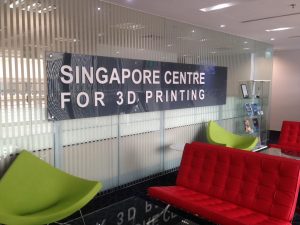If you’re looking to learn about additive manufacturing (AM), you want to make sure the educational institutes you’re applying to will have a 3D printing lab. With 3D printers costing anywhere from a few hundred dollars to million-dollar-plus, the odds are that just about any university — or community college, makerspace, or public library has one or more 3D printers.
Remember that while you are, of course, looking for good 3D printing labs to have access to, you’re also assessing whether a lab’s machine inventory aligns with your goals, for example:
- Do they have 3D printers of the right type/technology? For example, Fused Deposition Modeling (FDM), Selective Laser Sintering (SLS), polyjet, Stereolithography (SLA), or Digital Light Processing (DLP), to name just a few.
- What materials will you be working with? Metals? Polymers? Concrete? Food? What non-AM manufacturing machines are also available, like CNC tools, along with scanning, measurement and testing gear?
- What fields of study are the schools’ 3D printers and other resources in support of?
- Will you be making design prototypes or testable/usable production items?
- Will you be exploring mass production? Are you making small objects, like jewelry or biological parts — or large rocket engines, houses, etc.?
- Does a lab only have established printers, materials, and methods to offer, or are they also pushing the envelope with cutting-edge offerings?
And don’t just look at what AM equipment a given university has in place. What’s their road map for whatever AM methods and 3D printers are coming over the next few years, along with new spaces?
Here’s a look at some of the educational institutions with additive manufacturing labs, to give you a sense of the range of what you might find, from a maker-lab of consumer-class machines up through mass production systems and the newest 3D printing techniques on the market:
Cornell University (Ithaca, New York)
With three commercial-grade 3D printers including a Stratasys Fortus 250mc 3-D FDM Printer and Stratasys uPrint 3-D FDM Printer, plus a 3D scanner and a range of design software, Cornell’s CTSC 3-D Printing Core Facility helps students master 3D printing techniques, and researchers quickly create new biomedical products for improving health. CTSC has been used to print, for example, hundreds of medical device prototypes, surgical training models, anatomical models, patient education tools and other models for students and faculty.
Duke University (Durham, North Carolina)
The 3D printing lab in the Technology Engagement Center of Duke University’s Innovation Co-Lab Studio offers students, faculty, or staff makerspace access to over eighty commodity-class 3D printers, for creating objects in a variety of materials, sizes, and resolutions.
to over eighty commodity-class 3D printers, for creating objects in a variety of materials, sizes, and resolutions.
Additionally, researchers at Duke work with state-of-the-art 3D printing – including laser sintering, polyjet, and new Carbon 3D SL (stereolithography) printers, allowing for different materials and higher resolutions.
Lehigh University (Bethlehem, Pennsylvania)
Lehigh University’s Additive Manufacturing Lab mission is to be “a teaching, learning, and research lab that embraces the use and implementation of all types of 3D printing.”
The lab has nearly two dozen consumer-grade FDM 3D printers, along with commercial-grade 3D printers including two Stratasys FDM machines plus a full-color binder jetting system, a multi-material/multi process system, an SLS printer, and a metal printer. These get used in everything from production builds to researching new processes and materials.
Nanyang Technological University, aka NTU Singapore (Singapore)

The mission of NTU’s Singapore Center for 3D Printing is “research development and industry adoption of additive manufacturing technology through collaborative projects with leading industry partners, and with schools and research centers within and beyond NTU.”
For example, SC3DP researchers “have successfully designed and printed customized orthopedic implants made from titanium-tantalum (Ti-Ta)… [and] Researchers from the Building and Construction programme have developed the capability to 3D print an unfurnished bathroom in about 9 hours.”
Northwestern University (Evanston, Illinois)
Northwestern University’s 3D Printing and Rapid Prototyping Lab offers “an array of cutting-edge additive manufacturing and reverse engineering technologies, with the capabilities to print in a wide array of plastic, powder, and metal materials.” The Lab’s 3D printer roster includes Stratasys Connex 350, Stratasys Fortus 250mc, Stratasys Fortus 380mc additive printers.
University of Maryland (College Park, Maryland)
The University of Maryland’s Terrapin Works, a subunit of Engineering Information Technology in the A. James Clark School of Engineering, was founded in 2014 “to put additive manufacturing into the hands of undergraduate and graduate students alike while also supporting faculty and the greater UMD Community in innovative areas of research and product development.”
This includes offering access to over 100 consumer, research and industrial-grade 3D printers — along with design systems and subtractive production, located in nearly a dozen and a half locations around the university campus, which include 28,000 square feet of lab space.
Virginia Tech (Blacksburg, Virginia)
Virginia Tech’s DREAMS (Design, Research, and Education Additive Manufacturing Systems) Lab offers researchers just about every type of 3D printer and printing, including a Stratasys Fortus 400mc FFF printer, and custom-built 3D printers — along with high-bay space for large-scale projects, and working with the university’s new Industry 4.0 lab. DREAMS Lab “thrust areas” include researching and developing new material systems, new manufacturing process chains, and new fabrication technologies.
And over in the university’s Department of Aerospace and Oceanography Engineering, the AOE Machine Shop gives faculty and students tradition and new tools including milling, CNC machining, CAD software, 3D printers for rapid prototyping. The AOE Machine Shop recently built up it’s collection of 3D printers and currently uses GrabCAD Shop to manage it’s prestigious lab.
Choosing the School for You
The above barely scratches the surface of the ever-growing roster of 3D printing labs at today’s universities — but should give you an idea of the breadth of offerings and geographic availability.



Be the first to post a comment.